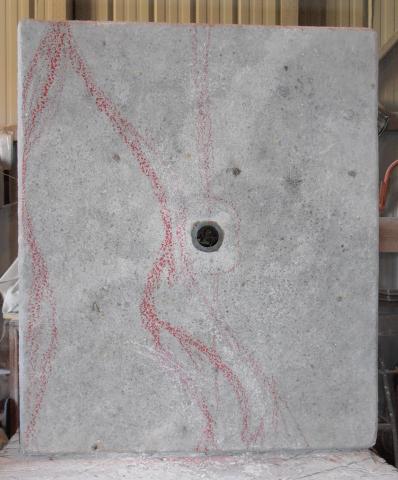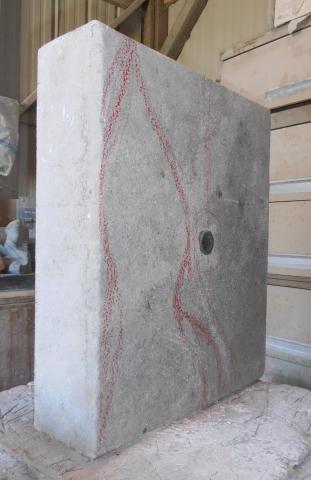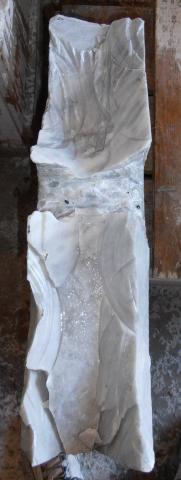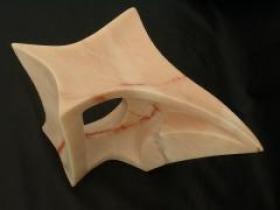
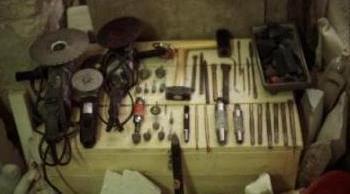
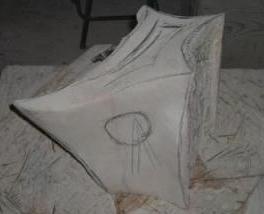

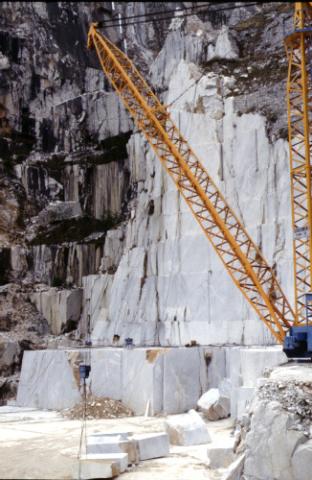
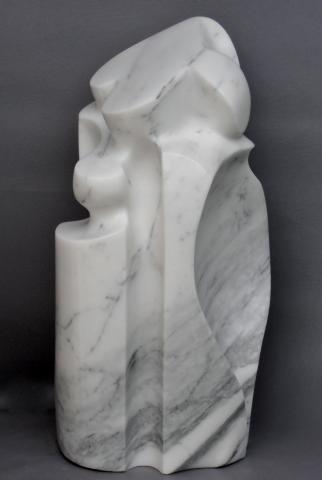
"Marble is a beautiful and durable material that has been used in construction and art for millennia. It is vulnerable to acid rain and to severe weathering, but when one begins to carve a piece of marble it feels quite hard and resistant.
"I enjoy working with a wide range of tools, from electric-driven dry diamond blades to hand and pneumatic chisels, electric and pneumatic die grinders, and even rasps and hand grinding stones. When I have essentially formed the piece, I hand wet sand it 5 to 7 times, with sandpaper or diamond pads, then polish and wax it.
"A metaphor I like to use when someone asks about carving marble and the patience it must take to do so is to ask them to think about some fairly short journey they might make versus a longer journey, say to a place 200 miles away. If the shorter journey takes 20 minutes and it is their only destination. they probably have a certain mental attitude about the time it will take to get there and their preparedness for the "journey." If, on the other hand, they were to follow the same route as the start of a journey to the farther destination, their attention and attitude would be different, hopefully less concerned and more patient. Similarly carving marble takes a lot of patience and effort, but if you don't try to rush things, if you accept the road ahead and find a fitting pace, it just becomes a journey to be experienced.
"The actual process I follow in making a piece of sculpture is to usually first conceive very generally of the form I wish to carve, such as, horizontal
versus vertical, the depth of the piece, the color of the stone, and any gesture(s) that might be appealing to me. I rarely sketch out a design ahead of time and when I do it usually bears little resemblance to the final piece. Especially these days, the preceding is an over-idealized version of how I would proceed. Given the realities of my economies and the availability of stone, I more often go to a stone supplier and see what is available and what among that appeals to me. I find a block that appeals to me, decide what side would be the base, and evaluate its desirability. When I get home, I wet the piece down to see if I had missed any particularly interesting veins, etc., then proceed to finalize my choice of the base side and to cut that side to be flat. I prefer to have my pieces free-standing, though sometimes the addition of a base is necessary for stability or dignity.
"Then I start to remove material that I find unnecessary or distracting. I remove weathered or faulted parts of the stone, pausing frequently to see what form seems to emerge out of the block. Carving like this is, fairly obviously, a subtractive process. Of course, pieces of stone or other materials could be glued or pinned, etc., to the piece, but I prefer to straightforwardly carve. It seems as if there is a difference to the mental set of subtracters and adders (those who prefer to work in clay or metal, for example). Some people can work across these boundaries, but I find it clearly easier to carve. Another facet of carving is that at the outset, the block is the entirety of the universe i will confront. There is actually a near infinity of variations possible within the block, but if that is so, how many infinities are possible with an additive medium?
"So, then I cut, chip, carve, sand, and repeat. Eventually I have to decide that the piece is finished; sometimes this is easy, sometimes, not.
"After the form is finished, I wet sand it with wet-dry sandpaper and diamond pads. (Often rasps and grinding stones find their way into this process.) Even with sandpaper alone it is possible to change the feel of a piece, the impact of it, to bend a curve or line this way or that. Then I polish and wax it. I prefer a glossy finish to my pieces, as opposed to a mat finish, which not only stains more easily, but also doesn't seem (to me) to be the full expression of the piece.
"Two last notes, once the piece is "done," I rarely like to go back and rework it. though occasionally I do. Also, based or not, I see the piece as entity with its own self-importance. To display a piece of sculpture on the floor is to say that its importance is that of something on that level (pedestrian?) I prefer to see my pieces on surfaces such that the top of the piece is below my eye level, but not by much. I'm just shy of 6 feet tall, so that means that a 30 inch high piece probably looks good to me sitting on a 30+ inch high stand, obviously a person of different height would want a different stand (too much information?).
"As of today (the end of May, 2014), I'm going to indulge in a bit of hubris. Below, the last pictures on this page are of a work in progress (actually 2 pieces). When I came back from Italy in 1989 I had a strange 6-foot high figure that I had worked on and a 6 in. high by 20 in. by 24 in. base for it to sit on. I later broke the piece (only semi-deliberately), but I've kept the base (which weighed 250+ pounds) for all these years. I finally decided that it would be a while before I would tackle anything that big again, so I decided to use the "base" as sculptural material. These pictures will loosely follow my progress with the now two pieces. I hope that they come out beautifully."
The Process


